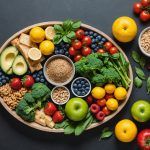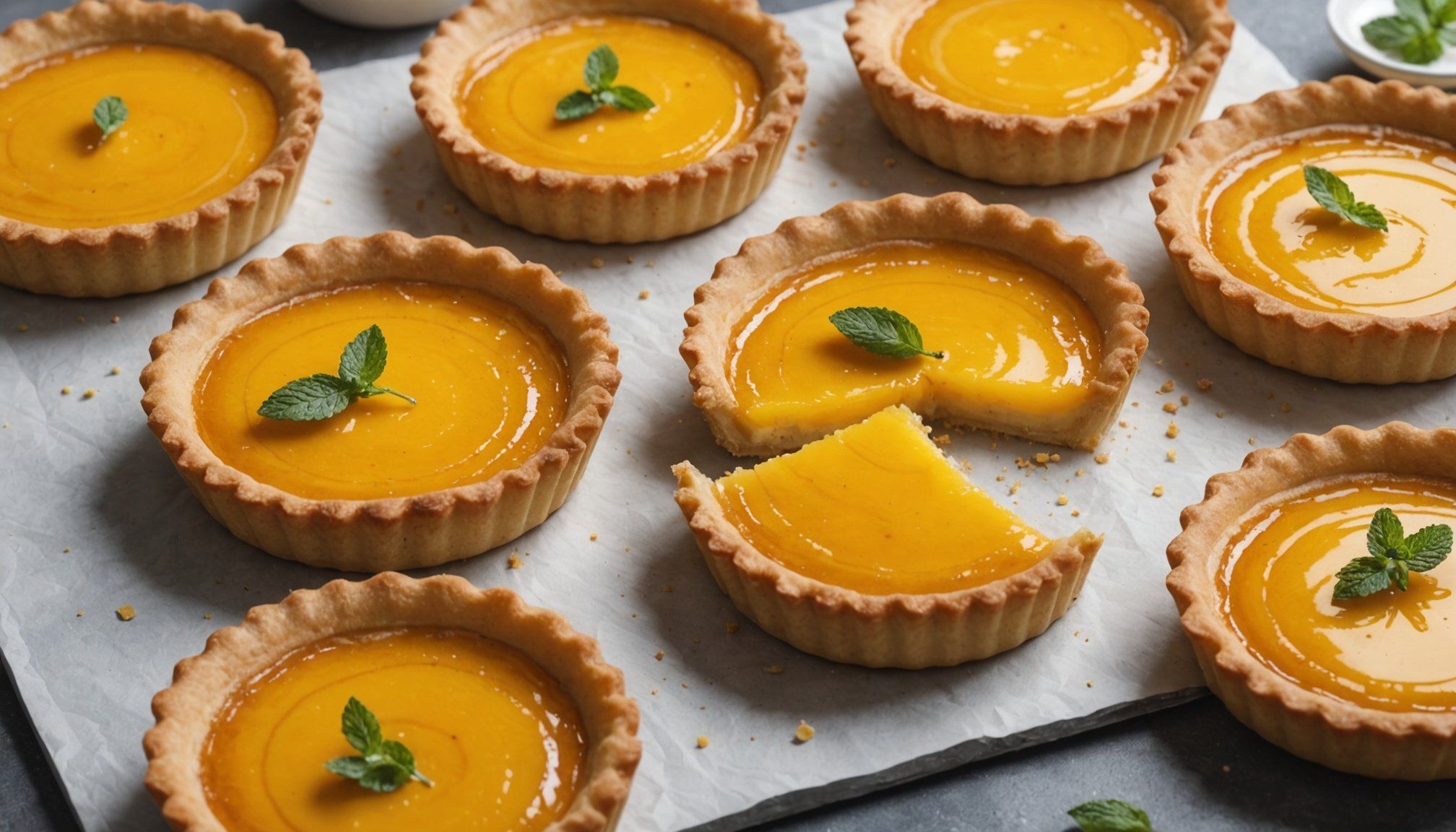Understanding the Basics of English Custard Tart
The English custard tart has a rich history that dates back to medieval times, where it was enjoyed by royals and nobles alike. Its cultural significance stems from its presence at celebratory feasts and gatherings, symbolising a treat for special occasions.
The custard tart is traditionally made with a few key ingredients. At its heart is the creamy custard filling, typically consisting of milk or cream, eggs, and sugar. These ingredients are carefully combined to achieve a silky texture and delicate sweetness. Nutmeg, a staple spice, is often sprinkled on top to add a subtle, aromatic touch.
In parallel : Discover the art of creating the ultimate traditional british christmas pudding: a comprehensive guide
Equally important is the pastry, which serves as the foundation of the tart. A well-crafted pastry shell should be both sturdy and flaky, providing a satisfying contrast to the smooth custard. This involves careful preparation, ensuring that the dough is chilled and rolled out evenly to prevent shrinking during baking.
Understanding these basic elements and their roles can help enthusiasts appreciate not just the taste but the craftsmanship behind an English custard tart. With practice and attention to detail, anyone can recreate this timeless dessert that continues to be cherished across generations.
In the same genre : Create the perfect crispy fish and chips at home: your ultimate guide to crafting irresistible tartar sauce
Key Ingredients for an Exceptional Custard Tart
To create a truly exceptional custard tart, committed attention to ingredient quality is essential. The foundation of a great custard base begins with fresh, free-range eggs and high-fat content cream. These elements ensure the custard is rich and creamy, providing a perfect texture balance. High-quality ingredients such as pure vanilla extract or fresh vanilla bean can significantly enhance the flavour, making the custard taste luxurious and fragrant.
When it comes to the pastry, opt for butter over margarine as it enhances the tart’s overall flavor and ensures a flaky, melt-in-the-mouth texture. Flour should be unbleached and fine to create a crisp crust that complements the soft custard filling. When sourcing ingredients, look for local farmers’ markets which may offer fresher and more flavorful options compared to supermarket supplies.
Flavor enhancements can further elevate the traditional custard tart. Adding a hint of nutmeg or a sprinkle of cinnamon can introduce an exciting twist to the classic flavor profile. For those adventurous, incorporating lemon zest or a touch of almond extract offers a unique and delightful variation, making each bite of the tart a delightful experience.
Step-by-Step Instructions for Making the Pastry
Creating a perfect tart requires mastering the pastry dough, understanding preparation techniques, and executing blind baking. Let’s explore each aspect meticulously.
Preparing the Pastry Dough
To begin with, achieving the right consistency in your pastry dough is crucial. Combine flour, chilled butter, a pinch of salt, and cold water. Use a cutting motion to ensure the butter mixes thoroughly without melting, creating a crumbly texture. This preparation technique helps develop a flaky structure in the final product.
Rolling and Shaping the Tart Shell
Once your dough is ready, roll it out evenly on a floured surface. Use a rolling pin for uniformity, turning the dough occasionally to maintain an even circle. The goal is to achieve a thickness of approximately 1/8 inch. Carefully drape the rolled dough over your tart pan, pressing it into the corners without stretching, to prevent shrinkage during baking.
Blind Baking Tips
Blind baking is essential to avoid a soggy bottom in your tart. Line the shaped shell with parchment paper and fill with baking weights or dried beans to prevent puffing. Bake at 350°F (175°C) until the edges are golden. Remove weights midway for even cooking of the base. Employing these techniques ensures a crisp foundation for any filling.
Mastering the Custard Filling
Achieving the perfect custard texture is both an art and a science. Understanding how ingredients interact is critical to creating the creamy, silky consistency that defines an excellent custard filling.
The Science of Texture
The primary goal in developing a desirable custard texture is ensuring that the proteins in the eggs are properly coagulated. This involves gently heating the mixture to allow the proteins to bind without curdling, resulting in smooth consistency. The interaction between sugar and the proteins plays a crucial role, as sugar slows down protein coagulation, offering a buffer against overheating.
Techniques for Success
Effective cooking techniques are key to maintaining custard texture. Begin by mixing the eggs and sugar thoroughly before gradually incorporating the milk and cream. Ensure uniformity in the mix, preventing any unwanted lumps. Utilizing a whisk is often recommended for best results. Strain the mixture through a sieve before cooking to eliminate any impurities or uncooked egg pieces.
Temperature Control
Temperature control is paramount. Cook the custard over low heat, whether it’s on the stovetop or in the oven. Use a thermometer to monitor the precise temperature, aiming for a range between 160°F and 180°F (71°C to 82°C). This ensures proper thickening without scrambling the eggs, resulting in the ideal custard texture.
Common Pitfalls and How to Avoid Them
Even seasoned bakers sometimes encounter baking mistakes, particularly when it comes to custard tarts. Troubleshooting these problems may feel daunting, but it’s perfectly manageable with a few essential tips. A common issue is a runny custard. Tarts sometimes come out of the oven not fully set because the custard mixture wasn’t sufficiently whisked or heated beforehand. Ensuring that the custard thickens slightly on the stove before baking can prevent this.
Another potential pitfall is overbaking, which leads to a rubbery texture. Setting a timer can help keep track of baking times, and vigilance is key. An underbaked pastry with a soggy bottom could result from not blind baking the pastry shell. Using pie weights to ensure the shell holds its shape in the first round of baking solves this.
Cracked custard tops might occur due to rapid baking or cooling. To troubleshoot, adjust the oven temperature—particularly if individual ovens run hotter than indicated. Cover the tarts with foil for part of the bake if cracking continues. Practice and small adjustments are crucial. Understanding your unique baking environment amplifies your ability to achieve perfect results and to transform errors into learning opportunities.
Creative Variations on the Classic Recipe
Exploring tart variations can be a delightful journey for both new and seasoned bakers. With an endless array of possibilities, the classic custard tart can be transformed into something extraordinary.
Seasonal Fruit Tarts
Using seasonal ingredients like fresh fruits can elevate your tart to new heights. Imagine the flavor customization possibilities: ripe berries in summer or spiced apples in autumn. Simply add thin slices or purées into your custard mixture before baking to create a refreshing contrast with the creamy filling. Experimentation with different fruits can produce surprising and delicious results.
Chocolate and Nut Variations
Adding chocolate or nuts introduces a rich and indulgent twist to custard tarts. Consider blending melted chocolate into your custard base or sprinkling crushed nuts atop before baking. Pecans, almonds, or even hazelnuts can provide a unique crunch, while enhancing the overall texture and complexity of the tart.
Unique Flavor Profiles
Diversify your baking repertoire by incorporating spices and herbs. A hint of cinnamon or cardamom can create cozy warmth, while fresh herbs like basil or mint infuse a distinct freshness. These subtle additions to your custard offer a unique flavor profile, turning a humble tart into a sophisticated masterpiece, perfect for any occasion.
Presentation and Serving Suggestions
Enhancing the visual appeal and enjoyment of a custard tart begins with creative plating techniques. Consider using a white plate to make the tart’s golden hue stand out. Add a drizzle of chocolate or fruit coulis around the tart’s perimeter for artistic flair. For an extra touch, sprinkle powdered sugar or a dash of cinnamon for colour contrast.
Garnishes are not just for aesthetics; they enhance flavour too. Top the tart with fresh fruit slices, like strawberries or kiwi, to introduce a refreshing tang that complements the custard’s richness. Alternatively, a sprig of mint can add a pop of green and a subtle aroma.
When it comes to serving, the tart is best enjoyed either slightly chilled or at room temperature. Avoid serving it too cold as it can dull the flavours, or too warm which might affect the texture. As for accompaniments, a dollop of whipped cream or a scoop of vanilla ice cream can create a delightful contrast with the dessert’s smoothness.
Pairing the tart with beverages can further enhance the experience. Coffee or a robust tea provides a bitterness that offsets the sweetness, while a light wine like Moscato adds a touch of elegance to the occasion.
Performance Measurement Techniques
In evaluating the Stanford Question Answering Dataset (SQuAD), multiple performance measurement techniques are essential for ensuring efficacy and precision. Key metrics include Precision, Recall, and the F1 Score.
Precision measures the accuracy of the predicted answers by evaluating how many of the predicted tokens are relevant compared to the total predicted tokens. It’s calculated as the number of true positives (tp) divided by the sum of true positives and false positives (fp). Therefore, Precision = tp / (tp + fp). High precision indicates fewer irrelevant words in the prediction.
Moving forward, Recall quantifies the ability of the system to correctly identify all relevant answers by comparing the found correct tokens over the total actual correct tokens. This is represented by Recall = tp / (tp + fn), where fn signifies false negatives. High recall suggests thorough identification of all relevant answers, reducing omissions.
The F1 Score combines Precision and Recall into a single measure. It balances the two metrics for scenarios where a balance between precision and recall is required. Thus, F1 = 2 _ (Precision _ Recall) / (Precision + Recall). By understanding these measurements, evaluating language models on SQuAD becomes more robust, aiding in the continuous improvement of AI systems.









